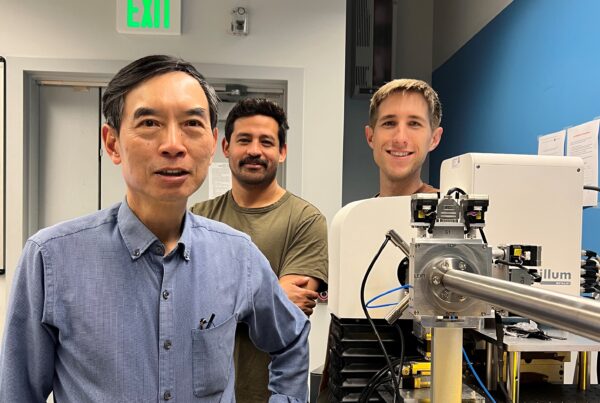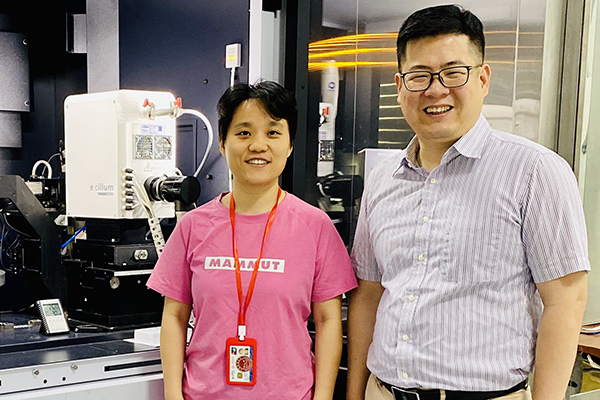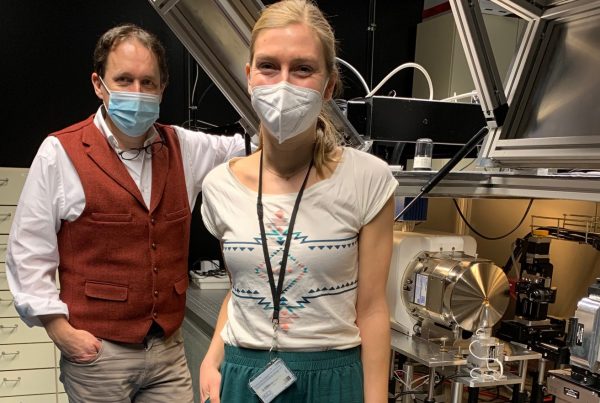Probing electronic structures in chemical catalysis
At the Max Planck Institute for Chemical Energy Conversion in Germany, Professor Serena DeBeer’s research group is leading the way in new developments in X-ray Emission Spectroscopy (XES). To further their catalysis research program, the group is currently carrying out large volumes of experiments using an in-house X-ray emission spectrometer based on an Excillum MetalJet X-ray source.
Lead researcher
Professor Dr. Serena DeBeer
Institute
Max Planck Institute for Chemical Energy Conversion, Germany
Method
X-ray Emission Spectroscopy (XES)
Application
Chemical catalysis research
X-ray sources
Excillum MetalJet D2+
Lead instrument designers
Dr. Wolfgang Malzer, Professor Dr. Birgit Kanngießer
Our own instrument allows us to do in-house dispersive X-ray emission from 2.3 keV, which is lower than what we’ve ever measured at a synchrotron. It gives us a much larger accessible energy range and, of course, we have access to it 365 days a year, as opposed to a few weeks a year. So, it really changes how much exploratory research you can do, how much you can test ideas, and so on.

Prof. Dr. Serena DeBeer
The new laboratory spectrometer was designed by the technology development team (BLiX), part of Birgit Kanngießer’s research group at the Technische Universität Berlin, in order to better exploit the potential of X-ray Emission Spectroscopy in chemistry research. Thanks in part to the unique brightness and focus of the MetalJet source, the instrument enables high-throughput experimentation on a wider range of elements than was previously possible.
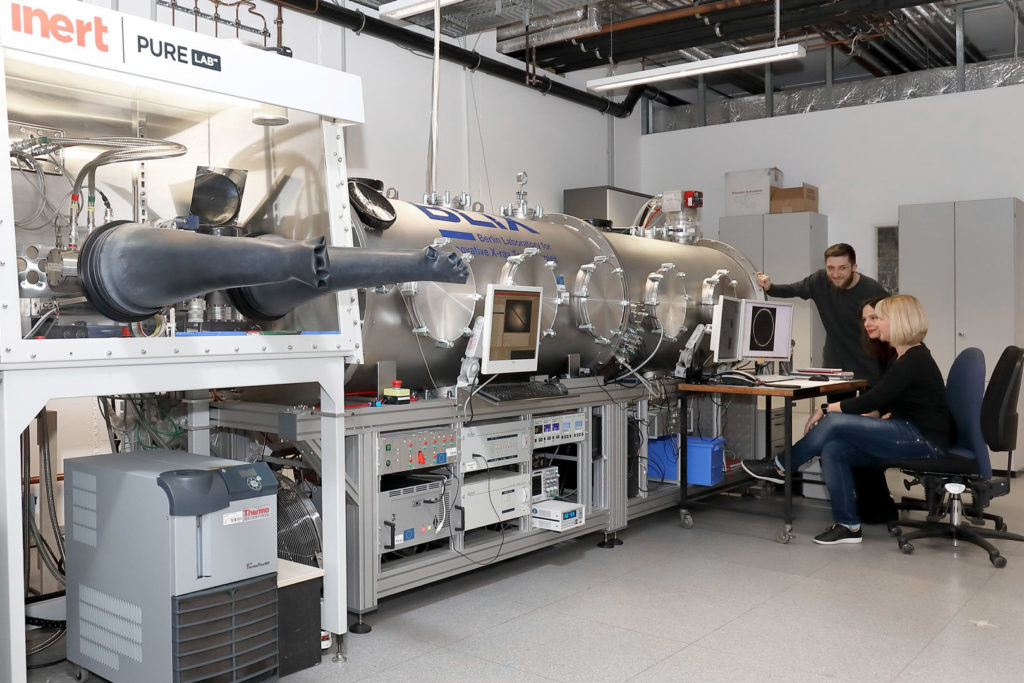
Professor Dr. Serena DeBeer (middle) with colleagues Chris Feike and Yvonne Brandenburger in front of the new laboratory spectrometer
Improved access and flexibility
Prior to having a laboratory-scale source, the team had performed a substantial number of X-ray emission experiments at a synchrotron, where accessibility was limited. “But even there we were mainly doing XES measurements in a relatively high energy regime, and always in a scanning mode,” Serena explains. “Our own instrument allows us to do in-house dispersive X-ray emission from 2.3 keV, which is lower than what we’ve ever measured at a synchrotron. It gives us a much larger accessible energy range and, of course, we have access to it 365 days a year, as opposed to a few weeks a year. So, it really changes how much exploratory research you can do, how much you can test ideas, and so on.”
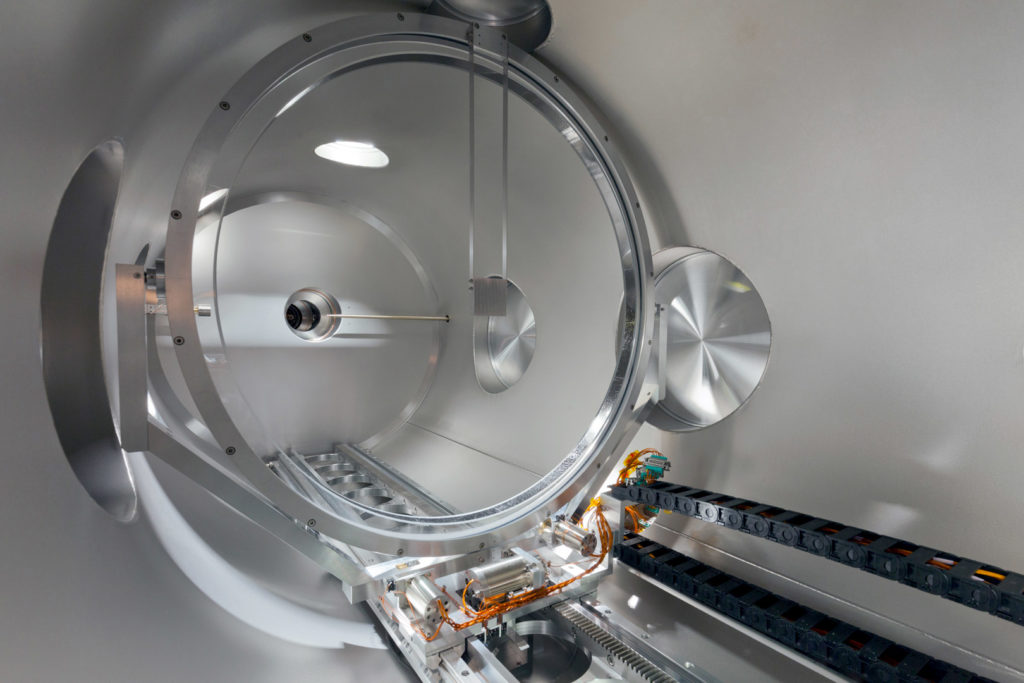
Inside the instrument at MPI CEC – showing the von Hamos full cylinder optic with Highly Annealed Pyrolytic Graphite (HAPG) as a dispersive element. In the back right of the image the polycapillary optic connected to the MetalJet D2+ can be seen1
The instrument offers the lab greater flexibility to improve research workflows, or to tailor the setup more specifically toward current research areas. “Sometimes we use the instrument just to pre-screen samples because, obviously, it’s still not as intense as a synchrotron,” says Serena. “But in some cases, like in our calcium emission paper, all the experiments were done entirely with our in-house source. At the moment, there still isn’t a great synchrotron setup to do similar experiments.”
The research she cites, recently published in Inorganic Chemistry, used valence-to-core XES to probe the electronic structure of calcium compounds. The method provided additional insights that complement the geometric information available from other techniques.
One of the reviewers of the paper asked us to provide the parallel synchrotron measurements for the calcium and we had to say, ‘Look, there isn’t actually a synchrotron beamline where we could do this at the moment.’
Tailoring a new X-ray instrument
About six years ago, Serena learned about the Excillum MetalJet while looking into new microfocus X-ray sources. One instrument manufacturer was able to supply an instrument including a MetalJet, but the combined optics weren’t ideal for her application. Based on several experiments and refinements performed by Excillum, the BLiX technology development team was able to evaluate other focusing options in order to confirm the best optics to pair with the MetalJet. “It was great for us that Excillum was really interested in a new scientific application,” says Serena. “They were very willing to explore different avenues in terms of optics, which was helpful for us during our instrument design phase.”
…in some cases, like in our calcium emission paper, all the experiments were done entirely with our in-house source. At the moment, there still isn’t a great synchrotron setup to do similar experiments.
Asked about the potential of MetalJet for new types of research within her field, she explains: “I do see it as a breakthrough in that the previous prototype instrument we were using offered a good microfocus, which is important because this focus defines our resolution. But we also need a relatively high photon flux — a relatively high-brilliance source in a small spot — in order to actually measure real catalytic systems. It’s this combination that’s really important for us in order to perform time-resolved experiments where we can detect the entire spectrum at once. And to do that, we need a relatively tight focus of around 30 microns with as a high a flux as possible.”
To further exploit the benefits of the X-ray source, Serena acknowledges that a lot of opportunities relate to the development of new, more sensitive detection methods: “The interesting part to me is that the MetalJet itself has, in many ways, all that we need for our experiments — even for dilute samples. The major improvement we need now, in terms of instrumentation, is actually on the detection side. The problem with most X-ray spectroscopy experiments is that we’re detecting far less than one percent of the solid angle. So if we could improve that, I think what we could do with a MetalJet is almost endless.”
Expanding possibilities for in-house research
Another exciting possibility, she adds, is to combine multiple X-ray methods such as small-angle X-ray scattering (SAXS) and tomography, or diffraction and spectroscopy, within a single in-house setup. “There’s no reason MetalJet wouldn’t work well for that,” says Serena. “To some extent these combined methods happen at synchrotrons, but one hasn’t seen it that much in-house yet. Because as synchrotron beam lines become more and more specialized, there is a lot to be said for having your own setup, both for better access and to tailor it to your own needs. That’s why, for instance, I have the integrated glove box. It’s not something I ever had at the synchrotron, but I deal with a lot of sensitive samples, so I really like that I can tailor it to exactly the kind of research we do.”
The ultimate aim of the team’s work at the institute is to carry out fundamental research in energy conversion processes in order to understand how one can most efficiently break or form chemical bonds using earth abundant catalysts. State-of-the-art X-ray spectroscopy will continue to be a core part of this research mission in the coming years.
I do see [the Excillum MetalJet] as a breakthrough in that the previous prototype instrument we were using offered a good microfocus, which is important because this focus defines our resolution. But we also need a relatively high photon flux — a relatively high-brilliance source in a small spot — in order to actually measure real catalytic systems. It’s this combination that’s really important for us in order to perform time-resolved experiments where we can detect the entire spectrum at once.
“If you think about our energy future,” says Serena, “we believe that one of the best ways to transport and store energy is in the form of chemical bonds, as long as you know how to release it in an efficient way. So that’s why I’m so interested in studying catalysts. In my group, we focus on spectroscopic methods to understand these functions on the atomic level. The idea is that this understanding can contribute to the design of better catalysts.”
1Malzer, W et al, “A laboratory spectrometer for high throughput X-ray emission spectroscopy in catalysis research”, Rev. Sci. Instrum. 89, 113111 (2018); https://doi.org/10.1063/1.5035171

